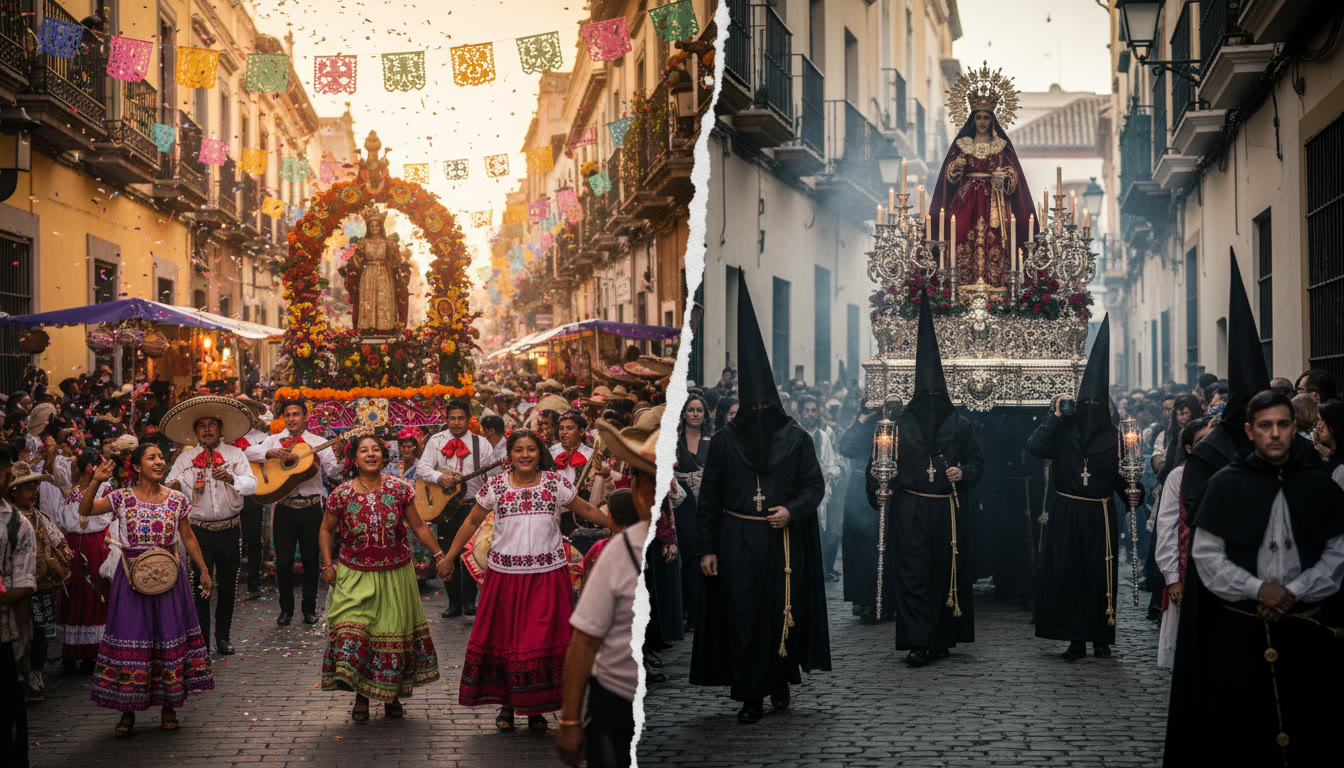Why Cultural Comparison Matters for AP Spanish
Comparing cultures is one of the most engaging and rewarding parts of AP Spanish. Beyond grammar drills and vocabulary lists, comparison tasks ask you to think critically, connect real-world observations to language, and express nuance in Spanish. Whether you’re preparing for the written comparison (comparación cultural), an oral presentation, or the speaking portion of the exam, mastering a clear structure and a bank of vivid examples will make your responses sound confident, precise, and—as importantly—human.

How Examiners Read Cultural Comparison Tasks
The AP readers look for three main things: comprehension, organization, and authenticity. That means:
- Understanding the cultural prompts and selecting relevant points.
- Presenting ideas in a clear, logical structure with transitions.
- Using accurate, natural Spanish that reflects cultural knowledge.
Think of the task as storytelling with purpose: you are painting a comparison that highlights both similarities and differences while showing why those differences matter.
Structured Template: A Reliable Framework
Before you try freestyle comparisons, memorize and practice with a flexible template. Use it as a scaffolding you can adapt to any prompt. Below is a high-utility template that works for essays and spoken responses.
Compact Comparison Template (5–7 sentences per paragraph)
- Intro (1 paragraph): Present the topic and two cultures being compared. Include a thesis sentence that previews similarity and difference.
- Body Paragraph 1: Present a clear point of similarity with a specific example for each culture.
- Body Paragraph 2: Present a clear point of difference with specific examples and short explanations of why the difference exists.
- Conclusion: Summarize and reflect briefly—what can we learn from this comparison?
Expanded Template for Longer Responses
- Intro: Contextualize the cultural topic (1–2 sentences) + thesis (1 sentence).
- Para A (Similarity): Describe, support with example A and B, explain impact or meaning.
- Para B (Difference 1): Describe the difference, offer evidence, explain historical/societal reason.
- Para C (Difference 2 or Counterpoint): Describe the contrast, show nuance, mention any exceptions.
- Conclusion: Synthesize, suggest implications or a personal reflection tied to cultural understanding.
Key Phrases and Transition Words That Win Points
Transitions and set phrases make your comparison coherent and show command of Spanish connective structures. Use them naturally—don’t memorize so rigidly that your speech sounds robotic. Here are categories and examples to practice:
Intro/Thesis
- En cuanto a…
- Al comparar…
- Si observamos…
Showing Similarity
- De manera similar,…
- Tanto en… como en…
- Igualmente,…
Showing Contrast
- Sin embargo,…
- Por el contrario,…
- A diferencia de…
Explaining Cause/Effect
- Esto se debe a…
- Como resultado,…
- Debido a…
Concluding/Reflective
- En resumen,…
- En conclusión,…
- Esto demuestra que…
Sample Cultural Comparison: Festivals and Community
Below is a model response you can adapt. Read it first in English to understand the logic, then study the Spanish version for structure and vocabulary. Notice how details make the comparison feel real.
| Aspect | Spain | Mexico |
|---|---|---|
| Main Festival | La Semana Santa (Holy Week) | El Día de Muertos (Day of the Dead) |
| Community Role | Religious processions and neighborhood brotherhoods | Family altars and neighborhood ofrendas |
| Typical Symbols | Procesiones, pasos, nazarenos | Calaveras, flores de cempasúchil, velas |
| Social Meaning | Tradition and local identity within Catholic rituals | Remembrance, celebration of life, syncretic indigenous and Catholic traditions |
Model Spanish Paragraph (short):
En muchas comunidades de España y de México las fiestas tradicionales consolidan la identidad local. Por ejemplo, la Semana Santa en Sevilla reúne a vecinos y hermandades en largas procesiones que destacan por su solemnidad y devoción. De manera similar, el Día de Muertos en Oaxaca convoca a las familias a decorar altares y a celebrar la memoria de sus antepasados con música y comida. Sin embargo, mientras que la Semana Santa enfatiza la expresión pública de la fe dentro de un marco litúrgico, el Día de Muertos mezcla elementos indígenas y católicos para celebrar la vida y la muerte de una forma más festiva. Esto demuestra cómo dos celebraciones pueden cumplir funciones sociales parecidas —fortalecer la comunidad— pero expresarlo con símbolos y tonos diferentes.
Building Cultural Examples: What Counts as Good Evidence?
Examiners reward specificity. Avoid vague claims like “in Spain they celebrate more” or “in Latin America people are very family-oriented” without examples. Good evidence includes:
- Concrete traditions (processions, rituals, foods, music).
- Named festivals or historical events (Semana Santa, Día de Muertos, Carnaval, Inti Raymi).
- Short anecdotes or hypothetical classroom experiences (“En mi clase, una estudiante de Madrid explicó…”).
- Social functions or causes (religion, colonization, migration, geography).
Common Topics and Quick Idea Seeds
Practice these themes with 3–4 mini comparisons each (two-sentence examples). They’re frequent on AP prompts and let you reuse vocabulary efficiently.
Food and Dining
- Siesta culture versus late-night dining habits.
- Tapas as communal eating in Spain vs. pozole or tamales at Mexican family gatherings.
Family and Social Structure
- Nuclear vs. extended family emphasis; migration shapes transnational families.
- Role of grandparents in childcare in many Latin American countries.
Holidays and Rituals
- Religious festivals (Semana Santa) vs. syncretic indigenous celebrations (Inti Raymi).
- Public holidays that emphasize national identity (Día de la Independencia) and local observances.
Media and Youth Culture
- Use of social media platforms can be similar, but local music trends and slang differ greatly.
- Television and telenovelas vs. streaming shows shape cultural references for young people.
Language Tips: Nuances That Sound Native
Small grammatical choices make a big difference. When comparing, practice these forms often:
- Subjunctive for uncertainty and opinion: Es posible que muchas familias celebren…
- Imperfect vs. preterite to situate traditions historically: Antes se celebraba… / En 1990 se hizo…
- Passive or se-impersonal to focus on practices: Se celebra con música y comida.
Also, use culturally loaded verbs and nouns: festejar, conmemorar, rendir homenaje, la costumbre, la tradición, la ofrenda, la procesión, la cofradía.
Practice Exercises You Can Do in 15–30 Minutes
Short, focused practice beats marathon cramming. Try these quick drills three times a week.
- Choose a topic (food, holiday, family). Write a 150-word comparison with one similarity and one difference.
- Record yourself speaking the same comparison for 90 seconds. Listen and note two pronunciation areas to improve.
- Swap written paragraphs with a peer or tutor and ask for one grammar correction and one comment about cultural accuracy.
Scoring Yourself: Short Rubric
Use this mini-rubric after each practice to track progress.
| Category | Target |
|---|---|
| Clarity of Thesis | Clear sentence presenting both cultures and previewing comparison |
| Evidence | At least one concrete example per culture |
| Language | Minor errors only; good use of transitions and varied structures |
| Fluency (speaking) | Speech is coherent with modest hesitations; 70–90 words/minute is fine |
How to Use Sparkl’s Personalized Tutoring Effectively (If You Choose It)
Personalized help can accelerate improvement if used actively. If you work with a tutor—like those at Sparkl—focus the sessions on:
- Targeted feedback on cultural accuracy and idiomatic language rather than broad corrections.
- Practice under timed conditions for the speaking and written parts.
- Tailored study plans that highlight your weaker grammar points and the cultural topics most likely to appear on the exam.
Sparkl’s 1-on-1 guidance, expert tutors, and AI-driven insights can help you turn specific errors into lasting habits by giving instant corrections, model answers, and personalized practice schedules. Use their support to practice realistic prompts and to get focused feedback on nuance—this is the most exam-relevant kind of tutoring.
Common Mistakes and How to Avoid Them
Below are predictable pitfalls students make and quick fixes you can practice immediately:
- Too-general claims: Replace “people in Spain/Latin America” with “many Spaniards” or “in several Mexican regions” and add an example.
- List-like writing: Use transitions to connect ideas rather than listing facts. Turn lists into causal or comparative sentences.
- Overly literal translations: Think in Spanish structures. Practice set phrases rather than translating from English word-for-word.
- Weak conclusions: Avoid repeating the intro—end with a short reflection about significance or a suggestion for further inquiry.
Real-World Context: Why Cultural Knowledge Matters Beyond the Exam
Understanding cultural differences is a skill that goes far beyond scoring well on AP Spanish. It prepares you for travel, for college classes that examine global issues, and for workplaces where cultural sensitivity matters. Employers and universities value students who can not only speak another language but also interpret cultural meaning—why rituals persist, how migration reshapes families, and how history informs present-day practices.

Putting It All Together: A Full-Length Example
Below is a model full-length comparison you can study and adapt. It demonstrates how to weave evidence, transitions, and reflection into a complete piece suitable for an AP prompt.
En muchos países hispanohablantes las celebraciones públicas cumplen una función social parecida: unir a la comunidad y reforzar la identidad local. Por ejemplo, en España la Semana Santa se celebra con procesiones solemnes, pasos que representan escenas religiosas y la participación activa de hermandades locales. Estas manifestaciones son, en apariencia, actos de devoción, pero también sirven para marcar la identidad de cada barrio y para reunir a varias generaciones. De manera similar, en México el Día de Muertos reúne a familias alrededor de altares decorados con flores y ofrendas; aunque su tono es más festivo, también cumple la función de recordar y honrar a los antepasados. Sin embargo, la diferencia clave reside en la mezcla de orígenes y en el tono: la Semana Santa está profundamente arraigada en tradiciones católicas europeas y suele acentuar la expresión pública del luto y la devoción, mientras que el Día de Muertos combina elementos indígenas y católicos, celebrando la muerte con canciones, colores y comida. Esta diferencia se explica en parte por la historia colonial y por la persistencia de prácticas indígenas en muchas regiones de México. En consecuencia, aunque ambos eventos fortalecen los lazos sociales, cada uno lo hace con símbolos y lenguajes distintos que reflejan trayectorias históricas y prioridades culturales desiguales. Entender estas diferencias nos ayuda a apreciar la riqueza del mundo hispanohablante y a evitar generalizaciones simplistas sobre lo que “la cultura hispana” significa.
Final Tips: Study Plan for the Last 4 Weeks
If you have four weeks left before an AP Spanish assessment, here’s a focused plan that balances cultural content with language practice.
- Week 1: Create a list of 12 cultural topics (food, festivals, media, education, family, migration). For each, write a 100–150 word comparison.
- Week 2: Record 10 two-minute oral comparisons. Transcribe them and correct grammar with a tutor or a study partner.
- Week 3: Timed practice — two full written comparisons under exam conditions; get feedback and revise.
- Week 4: Review mistakes, practice weak grammatical structures, and do daily 15-minute vocabulary drills focused on cultural terms.
Consider scheduling at least two targeted 1-on-1 sessions with an expert tutor to refine your weakest areas—Sparkl’s tailored study plans and AI-driven insights can help you prioritize which topics to focus on and provide model responses that mirror exam expectations.
Closing Reflection
Mastering cultural comparison is as much about curiosity as it is about technique. The best responses blend factual knowledge with personal insight, structured organization, and natural Spanish. Practice deliberately, collect real examples, and seek feedback that focuses on nuance. With consistent effort—and occasional targeted tutoring to accelerate progress—you’ll write comparisons that are both exam-ready and genuinely insightful. Buena suerte: your cultural curiosity is already the most powerful tool you have.


















No Comments
Leave a comment Cancel